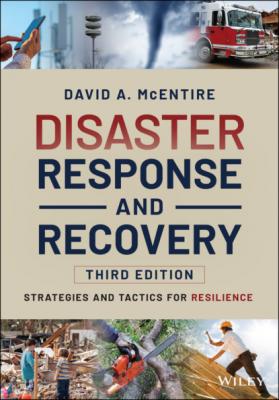Disaster Response and Recovery. David A. McEntire
Чтение книги онлайн.
Читать онлайн книгу Disaster Response and Recovery - David A. McEntire страница 15
 Phil Politano (Onondaga Community College), James Richardson (San Antonio Community College), William L. Waugh Jr. (Georgia State University), Cherlyn Wilhelmsen (University of Idaho), and Stacy Lynn Willet (University of Akron), Jane Kushma (Jacksonville State University), and DeeDee Bennett (University at Albany). The constructive advice of Gregg Dawson, Steve Reddish, Leland Baker, and other professional emergency managers is likewise noted.
Phil Politano (Onondaga Community College), James Richardson (San Antonio Community College), William L. Waugh Jr. (Georgia State University), Cherlyn Wilhelmsen (University of Idaho), and Stacy Lynn Willet (University of Akron), Jane Kushma (Jacksonville State University), and DeeDee Bennett (University at Albany). The constructive advice of Gregg Dawson, Steve Reddish, Leland Baker, and other professional emergency managers is likewise noted.
I also wish to recognize my wonderful daughters ‐ Ashley Layton, Kailey Birchall and Madison McEntire ‐ for their assistance in developing the supplementary materials for the text. Their contributions have definitely made an overwhelming task more manageable.
Finally, Wiley’s staff, including Summers Scholl, Daniela Bez, Viniprammia Premkumar, Karyn Drews, Laura Town, Jorkill Almanza and Sandeep Kumar, deserve credit for their time‐consuming preparation of this manuscript for publication.
David A. McEntire, Ph.d., SFHEA
About the Companion Website
This book is accompanied by a companion website:
www.wiley.com/go/mcentire/disasterresponse
The book companion site is split into as follows:
The student companion site includesPre‐Test documents: contain multiple choice questions and solution.Post‐Test documents: contain questions and answers.Manual documents: contain the solutions to questions in the book.Midterm document: test template without answers.“Cumulative Final” document: test template without answers.
The instructor companion site includesMidterm document: test template with answers includedCumulative Final document: test template with answers included.PowerPoint Slides: contain presentation slides for lectures
1 Knowing What to Expect: Hazards, Vulnerability, and Disasters
STARTING POINT
Pretest to assess your knowledge on hazards, vulnerability and disasters.
Determine where you need to concentrate your effort.
What You’ll Learn in This Chapter
The possibility and probability of disasters.
General emergency management responsibilities.
Types of natural, technological and anthropogenic hazards.
The interaction of hazards and vulnerability.
Anticipated changes and demands after disasters.
The need for response and recovery operations.
After Studying This Chapter, You’ll Be Able To
Understand the impact and scope of various disaster levels.
Differentiate among the diverse hazard categories.
Comprehend the relation among hazards, vulnerability and disasters.
Examine the relationship between response and recovery functions.
Identify needs to be addressed during and after disaster.
Goals and Outcomes
Compare and contrast different disaster magnitudes.
Define and use basic disaster and emergency management terminology.
Evaluate distinct types of hazards as well as common disaster characteristics.
Predict changes resulting from disasters and resulting implications.
Advocate for the importance of response and recovery operations.
INTRODUCTION
Welcome to the intriguing disaster discipline and the indispensable emergency management profession! As a current/future emergency manager or related specialist, it is vital that you are aware of the important concepts and principles relating to your duties and responsibilities that must be performed when disasters occur. It is especially imperative that you are able to distinguish among differing hazard types as well as the factors that lead to and exacerbate these devastating events. For instance, it is vital that you understand natural, technological, and civil/conflict triggering agents as well as how they interact with the vulnerabilities people and organizations create in society. Comprehending the causes and consequences of disasters and the changes that become visible when they unfold is likewise necessary if you are to be able to react to them effectively. Being cognizant of the goals pertaining to response and recovery operations will also help you become a successful emergency manager. These are a few of the topics addressed in this introductory chapter of Disaster Response and Recovery: Strategies and Tactics for Resilience.
1.1 The Occurrence of Disasters
Everyday people around the world are impacted by events that produce injuries, cause death, damage buildings/infrastructure, destroy personal belongings and interrupt daily activities. These disturbing experiences are categorized as accidents, crises, emergencies, disasters, calamities or catastrophes. Such incidents adversely affect individuals, groups, communities and even nations. Each of these events is similar in that they require action from government officials, businesses, nonprofit organizations, citizens/bystanders, and the victims and survivors themselves. However, these occurrences vary dramatically in terms of magnitude, extent of duration and scope. For example, a routine traffic accident can typically be handled within minutes or hours by a few police officers who file reports and a tow truck that removes wreckage. A structural conflagration may require one or two fire departments, but it can displace the resident or family for weeks or months. When a mass shooting occurs, resources are needed to neutralize the threat, investigate the incident, and address the longer‐term psychological toll that may possibly result from these intentional acts of violence. Alternatively, an airplane crash may necessitate the participation of firefighters and emergency medical service (EMS) personnel as well as airline officials and government employees such as a coroner or public information officer. If the plane crash does not take the lives of all of the passengers and crew, the victims and survivors of the ordeal may be injured or permanently disabled and require long‐term medical care. Finally, when a major earthquake or hurricane affects an urban area, many organizations will become involved. Besides first responders, additional personnel will be needed to remove debris, repair utilities, provide relief assistance and coordinate rebuilding endeavors that could take years. Thus, the impact of a minor accident is both quantitatively and qualitatively different than a major disaster or catastrophe (see Table 1‐1) (Quarantelli, 2006). While this book does discuss common emergencies and less frequent catastrophes, it focuses most of its attention on larger disasters and how to deal